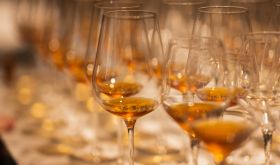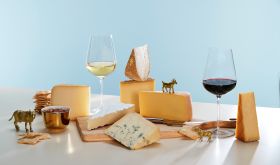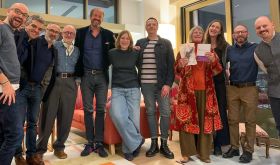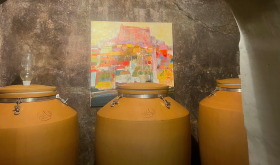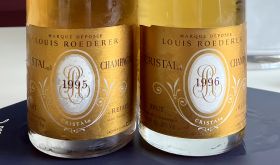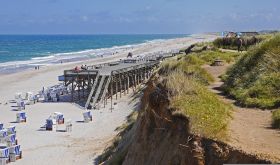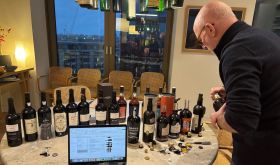Number 41 in our series of published entrants into our wine writing competition comes from Poland.
My name is Malgorzata Partyka and I am a 29-year-old woman, currently finishing her PhD studies in molecular biology (in the field of neurodegenerative diseases, totally unrelated to wine). I live in Warsaw, Poland.
My interest in wine started a few years ago during a stay in France and blossomed during a visit to Portugal, five years ago. Ever since I have been using every possible way to gain more experience with wine. I participate in wine events in various cities in Poland (for example in the recent meeting with Jancis Robinson in Krakow), but also travel to wine regions.
Last year I passed the WSET Higher Exam with distinction. To take up an active role in the wine world I have started a wine blog – Enowersytet, created with the technical support of my husband. I founded Enowersytet not only to share my opinion about tasted wines, but also to spread wine culture and knowledge in Poland. I stand out in the Polish blogosphere as the only blog publishing podcasts and interviews with winemakers.
The articles prepared for your competition maintain the style of my writing for Enowersytet. Therefore the first article is based on scientific reports and the second one was inspired by and refers to one of my interviews (published as a podcast in Polish on my blog but the article below is not published elsewhere).
MALAY SECRET OF A PERFECT TASTING NOTE
Native language shapes the way we think about and describe the surrounding world. Although unnoticeable in daily life, the presence of additional words would change and probably also improve our communication skills. (Tom Scott explains this phenomenon in his series.)
Would not the life of sommeliers, wine critics or tasters be easier if they had an additional set of words to describe aromas (like we do for colours, for example)? Would it not make wine tasting notes more accessible to the beginners in the wine world?
European languages lack the vocabulary to describe odours but the same is (quite surprisingly) not a general feature in human communication. The tongue of the Jahai tribe, living on the Malay Peninsula, is rich in words dedicated to the definition of smells.
Presence of such vocabulary clearly influences the Jahai culture. Thanks to an unusual (for us) set of linguistic skills the importance of smells and flavours is well understood to the Jahais from their childhood. These cultural conditions – flavour education from earliest years, associated with a vocabulary dedicated to define odours – enhance their abilities to describe smells.
As shown in this paper, the Jahai people are able to describe previously unknown odours more precisely than Americans who are better acquainted with the same smells.
Because our olfaction is tightly bound with the sense of taste, the limited range of odour-describing words reduces our ability to define flavours. Due to the absence of specific vocabulary, we are forced to use metaphors and comparisons to describe our favourite wines and dishes.
This linguistic limitation makes the process of wine description more complicated than one might suppose. Not only the activity of olfactory and gustatory senses and basic linguistic skills are required for precise description of wine, but also an association of sensual stimuli with memories and judgement skills is needed.
Although our senses’ sensitivity and learning abilities decrease as we age, as most wine lovers surely know, we are able to hone our tasting skills throughout our life.
What could have been only supposed, based on wine tasters' experience, was recently studied and confirmed by Sarah Banks and her American and Canadian collaborators. Their paper shows that extensive training in wine judging influences the structure and activity of the mature (adult) brain.
To be more precise – during the study of olfaction, Master Sommeliers and novices were asked to smell and discriminate between wine and liquids imitating the smell of wine. Magnetic resonance was used to image the structure and activity of their brains. This examination showed that the activity of sommeliers’ right hemispheres (dominant during the process of olfaction) is higher than that of less experienced people during wine vs fake-wine discrimination.
Similarly, the structure of subregions important for odour reception and memory (entorhinal cortex) is enhanced in the brains of well-trained wine tasters and its thickness increases with sommeliers’ experience. To choose the best wines for their clients, sommeliers have to combine information from their senses with external signals. The region known as right insula is important in that process and – as expected – one of subregions of the insula has a larger volume in sommeliers’ brains.
Even though the study showed that during wine judgement, the brains of experienced tasters work differently than novices’ brains, it did not explain how general such tasting skill can be.
It is reasonable to think that enhanced abilities of aroma differentiation, gained with experience in tasting, might influence general flavour definition skills. Do strong skills in the definition of wine aromas translate to the ability of describing odours and flavours?
That was a problem discussed by Ilja Croijmans and Asifa Majid in their recent study, published in PLoS.
In this research, the abilities of wine experts, specialists in coffee tasting and novices in the field of description of different aromas and flavours were compared. It appeared that, when asked for the identification of flavours and aromas of wines and coffees, wine experts described wine aromas and flavours most consistently. Specialists in wine tasting were also the best in the description of coffee flavours, but coffee experts presented the highest level of skills pertaining to the discrimination of various types of coffee.
Croijmans and Majid compared the choice of vocabulary that experts and less experienced people used to describe particular features of wines and coffees. While professionals used more source-based words to describe particular aromas and flavours (eg vanilla), novices preferred evaluative terms (eg nice).
Surprisingly, experts’ knowledge and description skills do not seem to enhance their general ability of identification of basic flavours and everyday aromas. Similarly to laypeople, the experts were able to correctly identify only about 40% of presented odour stimuli and 80% of taste stimuli. It appears that despite the ability to master tasting skills in one field, we are unable to completely make up linguistic deficiencies and lack of early flavour-description education.
Although we are not able to completely change our vocabulary resources and make taste description skills more general, we can improve the quality of wine parlance. I believe that most wine lovers do it frequently, by participating in exciting discussions which are an intrinsic part of every fruitful wine tasting.
This article was inspired by and based on:
Banks, S J, et al, 'Structural and Functional MRI Differences in Master Sommeliers: A Pilot Study on Expertise in the Brain', Frontiers in Human Neuroscience, 10/414, 22 August 2016
Croijmans I, Majid A, 'Not All Flavor Expertise Is Equal: The Language of Wine and Coffee Experts', PLoS One 11/6, 20 June 2016
MOLDOVA AND ROMANIA – THE STORY OF DIFFERENCES
Romania and the Republic of Moldova are two neighbouring, wine-producing countries in south-eastern Europe. Besides a common border, they share a complicated history and tradition. Despite these proximities, at a first glance it might be hard to find similarities when modern Moldovan and Romanian wine cultures are considered.
My native country, Poland, has been for a long time one of the biggest importers of Moldovan wines, which – sincerely speaking – are still much too often the perfect relics of communist times and examples of how wine should never taste.
Twenty-five years after transformation, high-quality wines from these countries are still hardly available in Poland, and supposedly their distribution to Western Europe is even poorer. However difficult to find, good examples of Eastern European wines are well worth trying.
Living in Warsaw, I recently met Alexandru Casianov, a 28-year-old native Moldovan, who came here to study and decided to stay and start his own wine-selling business. His mission is to change the poor image of Moldovan and Romanian wines.
Alexandru, during an intriguing conversation, presented the history of these countries, their similarities and differences. This interview not only allowed me to understand the current wine market situation in Romania and the Republic of Moldova, but also gave a perfect opportunity to get to know the history of the youngest Moldovan wineries and winemakers. Meeting Alexandru inspired me to dig deeper into the past of this region.
Areas of today’s Republic of Moldova and Romania share a tumultuous history. Multiple uprisings made them gain independence or lose it to the Ottoman Turks, Austrians, Hungarians (Austro-Hungarians), or Russians. As a result of these turbulent times, the historic region of Moldova is now divided between Romania and the Republic of Moldova. Western Moldova belongs to Romania, while the Eastern part – Bessarabia – constitutes the Republic of Moldova.
It is worth taking a step back to the beginning of the 19th century in order to better understand viticultural evolution in these countries. At that time, today’s north-western part of Romania remained under Austrian, Hungarian and Saxonian influences. Although locally too cold to produce high-quality wines, a large part of that area was covered with vineyards. Wine was produced not only for winegrowers’ personal consumption but also supplied to the Austro-Hungarian Empire.
At the same time, the historic Moldova, after years of Ottoman Turks’ occupation, fell under the influence of the Russian Empire. Due to religious reasons, Turkish occupants approved development of large-scale viticulture rather reluctantly. Russian aristocracy, on the other hand, appreciated perfect vine-growing conditions in newly annexed areas. Known for their love for French wines, the Russians decided to employ French-wine-savvy winemakers, and establish wineries. Some of them have survived till today. The region of Bessarabia acquired the highest prestige and popularity owing to wine production.
Under Russian influence, Moldavia started to be known for medium-dry and medium-sweet, sometimes even sparkling wines, fashionable in the Tsar’s court.
In 1861, areas of today’s Romanian region of Wallachia and historic Moldova proclaimed independence as the Kingdom of Romania. Their wines gained popularity even in Western Europe, which was forced to look for additional sources of wine due to phylloxera.
The Golden Age of Romanian wine did not last long – the epidemic of that devastating pest came to Romania in 1884, also destroying the precious Bessarabian vineyards.
After 1906, vineyards in the areas under the Tsar’s influence were to be planted with varieties such as Cabernet Sauvignon, Merlot, Pinot Noir, Aligoté or Chardonnay, which still dominate in the Republic of Moldova today.
The opposite decision was made in Romania, where more productive hybrids, better suited to less favourable climate conditions of some regions became popular. Vineyard nationalisation after World War II additionally exacerbated the poor situation of local viticulture.
The incorporation of Moldova into the USSR during World War II meant a definitive end of traditional viticulture in the country. Respecting the commands of Soviet dictators, Moldova, being at the same latitude as France, should have become the France of Eastern Europe.
Wishing to eliminate influences of Romanian culture from Moldova, USSR leaders did not forget to get rid of the remnants of local grape varieties, such as Fetească Albă, Fetească Regală, and Fetească Neagră. Despite its small area, Moldova became one of the main wine exporters of low-quality, often semi-dry or semi-sweet wines to Russia and the countries of the former Eastern Bloc.
Moldova's declaration of independence in 1991 did not influence wine export to Russia, still an importer of 60% of wine produced in Moldova, where a quarter of the entire population was engaged in wine production.
In the People’s Republic of Romania, the quality of wine produced in big, state-owned wineries mainly for the local market was no better. The first free elections in 1990 and the ratification of the new constitution in the next year were the first steps leading to privatisation of national vineyards. This also created opportunities for foreign investors. Some of them created huge companies, producing different styles of wines in numerous regions, using local as well as international grape varieties.
Among them were Englishmen John E Halewood and Dan Muntean, owners of the Halewood group, and Philip Cox, the owner of Cramele Recaș winery, currently dominating wine production in the region of Banat. Another big company started at that time is Vinarte, established by investors from Romania, France and Italy.
However, modern Romanian wine should not be associated only with these enormous investments. Although the promotion of such wines seems to be a little bit forgotten, Romania has become a place for development of small, family-owned wineries.
One of them is La Sapata (‘shoe’ in Italian), being the first organic winery in Romania. La Sapata was created by Italian siblings Roberto and Emma di Filippo, who own a wine estate in Umbria as well. Roberto Pieroni helped them to establish their wine, and has remained a part of the team. The wines are produced from red Băbească Neagră and white varieties – Fetească Regală, Welshriesling and Aligoté – growing in their vineyards in Danube Delta (in Dobrogei, the south-eastern corner of Romania).
Another interesting producer is Petro Vaselo, established in 2005 by an Italian businessman Nello Dal Tio. Having fallen in love with Romania, Nello decided to invest in his own winery a part of the money from his earlier, highly successful project (production of coffee machines). For 11 years, this Italo-Romanian organic winery in the Banat region has developed production of still wines from local and international varieties as well as traditional-method sparkling wines.
While modern viticulture in Romania started blooming at the end of the 20th century with the huge contribution of foreign investors, in Moldova the situation looked different.
Until 2006 Moldovan viticulture, remaining in close connection with the Russian market, had been deprived of any reasons for modernisation. The situation changed after a Russian embargo on Moldovan wines in 2006, which forced Moldovans to look for new markets for their wines. It was a time when local, small, and ambitious wineries might start to show up. Some of them combined their efforts, creating the Moldovan Small Wine Producers Association.
One of such small wineries with a very interesting history is Et Cetera. The project was launched in 2002 by Alexandru Luchianov, joined four years later by his brother Igor.
Alexandru, despite the initial lack of proper wine education, decided to start his own wine business under the influence of his American friends. Working in the US, one day he brought some bottles of Moldovan wine to America. To his deepest disappointment, instead of appreciation he heard only voices of strong disapproval when his friends tasted the wines.
A few years later, having earned enough money to start a business, he came back to his motherland, bought a small vineyard (presently 33 hectares / 81.5 acres) and established the winery. Currently Et Cetera successfully produces 13 types of wines using mainly international grape varieties.
Many young Moldovan winemakers receive their education from foreign (mainly French) wine schools, but they get the basis of the art of winemaking in their country. The school in the city of Nisporeni gives them not only an opportunity to learn the theory, but also to produce wine. The wine, made by adepts of the school is available in Moldova under the name of Crescendo. This perfect (and tasty) idea has only one defect – until now no wines from local grape varieties have been produced.
Fortunately, varieties such as Fetească Alba, Fetească Regală and Fetească Neagră, even if forgotten by older generations, are gaining popularity again. This is possible thanks to the work of modern-style winemakers, such as those from Carpe Diem winery.
Under the pressure of an economic crisis, Moldovan winemakers made the effort to promote their best wines and created the National Office for Vine and Wine, established to improve the quality and boost the popularity of Moldovan wines.
Their efforts have become noticeable in the markets of their main importers and, it is hoped, will continue to change the image and availability of Eastern European wines not only in these markets but also in Western Europe.



